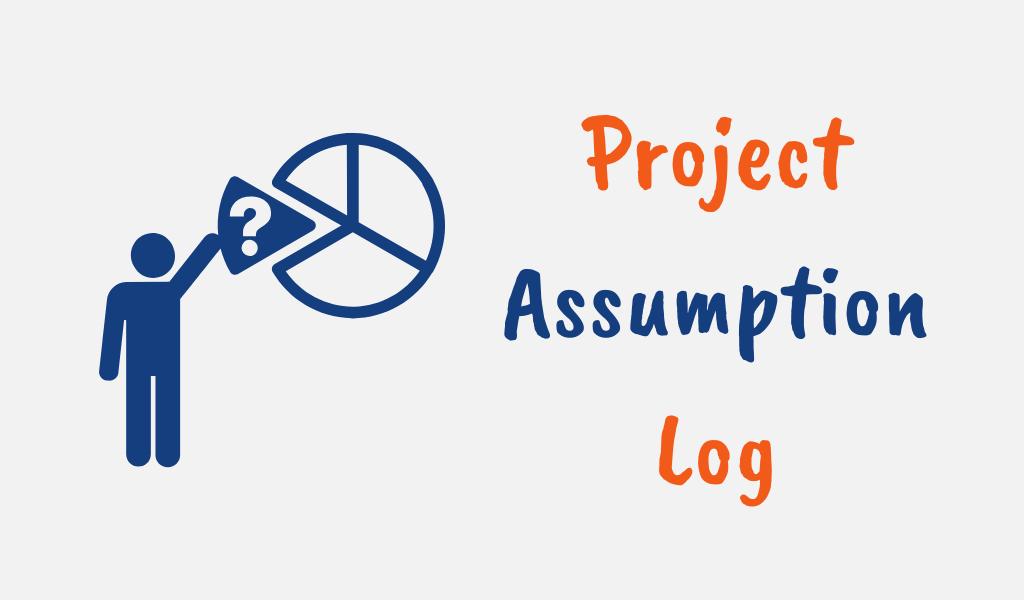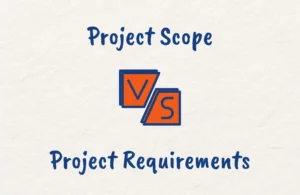When planning for a project, you never fully know what to expect when the actual project work starts.
However, you still need to plan for the entire duration of the project especially when using a predictive or waterfall approach. This is where project assumptions are needed.
Assumptions are an important part of planning projects, and it is also vital that they are documented with the use of Assumption Logs.
This post takes a look at project assumptions and the role the Assumption Log in project management plays as well as a customizable Assumption Log template that you can download and use.
We’ll also provide Assumption Log PMP exam tips to help answer questions on the topic that you may encounter if you are taking the exam.
What are Assumptions in Project Management?
Assumptions in project management are accepted facts or possibilities, considered true without proof during project planning that form the basis for planning and decision-making, reducing uncertainty.
In the words of the Project Management Book of Knowledge (PMBOK) 7th Edition, “An assumption is a factor that is considered to be true, real, or certain, without proof or demonstration”.
While the term assumption is generally considered in a bad light, this is often necessary during the project planning phase to make certain decisions and there is insufficient information at that point to be absolutely certain.
However, the use of assumptions while often necessary carries inherent risk. If they prove to be incorrect, they can impact project schedules, budgets, or outcomes.
Therefore, proper documentation and regular review and validation of assumptions are critical to mitigate potential risks.
Common assumptions relate to schedule, cost, resource availability, stakeholder behavior, project requirements, and more.

Project Assumptions Examples
Project assumptions vary based on the type of project, but here are some general examples:
- Resource Availability: Assuming certain key personnel will be available to work on the project.
- Budget: Assuming that the budget will remain stable throughout the project duration.
- Schedule: Assuming that there will be no significant delays from vendors or other external parties.
- Technology: Assuming that the current technology being used will be sufficient for the project’s needs.
- Stakeholder Support: Assuming that all stakeholders will be supportive throughout the project lifecycle.
Importance of Assumptions in Project Management
Assumptions play a vital role in project management by providing a basis for planning and decision-making and are often used to fill gaps in knowledge that would be too costly or time-consuming to obtain.
Here are 5 ways assumptions are important in project management:
1. Risk Management
Assumptions usually carry inherent risks. If an assumption turns out to be incorrect, it can have a significant impact on the project’s schedule, cost, or quality.
Therefore, it’s important to identify and document assumptions as part of the risk management process.
2. Project Planning
Assumptions are used in the planning phase of a project to make estimates and forecasts.
For example, you might assume that certain resources will be available, that tasks will take a certain amount of time, or that other conditions will be met.
3. Decision Making
During the project lifecycle, managers often have to make decisions based on incomplete information. Assumptions help fill in the gaps and allow for more informed decision-making.
4. Communication
By clearly stating the assumptions upon which a project plan or decision is based, everyone involved in the project has a better understanding of the context and rationale.
This improves communication and collaboration among project team members.
5. Contingency Planning
If an assumption proves to be false, having a contingency plan in place helps to mitigate any negative impacts.
This is part of risk management and involves planning for alternative outcomes if assumptions do not hold.

Assumption Log in Project Management
The Assumption Log in project management is a document that contains all of the assumptions and constraints that a team makes while working on a project. It is created during project initiation and updated as the project progresses.
The Assumption Log allows for the identification, tracking, and management of assumptions to mitigate risks. It also aids in validating these assumptions and adjusting project plans when necessary.
A typical Assumption Log includes:
- A description of the assumption
- The reason for the assumption
- The impact if the assumption is incorrect
- The owner of the assumption
- The status of the assumption (e.g., confirmed, not confirmed)
What is the Importance of an Assumption Log?
An Assumption Log serves as a record of all assumptions made during the planning and execution phases of a project and is a vital document when managing projects.
The importance of an Assumption Log can be highlighted through the following points:
- Risk Management: An Assumption Log helps identify potential risks. If an assumption proves incorrect, it could impact the project negatively. The Assumption Log allows for these risks to be identified and managed proactively.
- Transparency: It enhances transparency by documenting all assumptions made during the project. This allows all stakeholders to understand the basis on which decisions have been made.
- Communication: The log acts as a communication tool, ensuring everyone involved in the project is aware of the assumptions being made.
- Tracking and Validation: Assumptions are not just made and forgotten. They need to be reviewed and validated regularly, and an Assumption Log allows for this systematic tracking.

How to Create a Project Assumption Log
Creating an Assumption Log for projects is a simple process, but it’s important to do it correctly to ensure that the log is effective.
Here are the steps to create an Assumption Log:
1. Identify Assumptions
During the planning phase of your project, it’s crucial to identify and record all the assumptions you’re making.
These could be about resources, tasks, timeframes, or any other factors that could potentially impact your project. Include assumptions made by both your team and stakeholders.
2. Create Your Assumption Log
This could be as simple as a spreadsheet or a table in a document. Your log should include the following columns:
- Assumption ID: A unique identifier for each assumption.
- Assumption: A brief description of the assumption.
- Owner: The person or team responsible for tracking and validating the assumption.
- Date Identified: The date the assumption was made.
- Status: The current status of the assumption (Valid, Invalid, or Need Verification).
- Impact if Invalid: A brief description of the potential impact if the assumption is found to be incorrect.
3. Validate Assumptions: Regularly review and validate your assumptions. This helps in proactively managing risks and allows you to update your project plan if necessary.
4. Update the Log: Keep the log updated with the status of each assumption and any changes that have been made.
5. Communicate: Ensure that all team members and stakeholders are informed about the assumptions and their status. This helps everyone understand the basis on which project decisions are made.
Assumption Log Example
Here is an example of what an Assumption Log might look like:
| Assumption ID | Assumption | Owner | Date Identified | Status | Impact if Invalid |
| A1 | All team members will be available for the entire duration of the project | Project Manager | 2023-08-10 | Need Verification | The necessary software licenses will be obtained by Q4 |
| A2 | The necessary software licences will be obtained by Q4 | IT Department | 2023-08-10 | Valid | Could prevent software development |
Assumption Log Template Excel
Download a free customizable Assumption Log template below.
How to Use a Project Assumption Log Effectively
Here are some tips for using a project Assumption Log effectively:
1. Start the Assumption Log at the beginning of the project: The Assumption Log should be created as soon as the project begins. This way, assumptions can be captured and tracked from the beginning.
2. Update the Assumption Log regularly: As the project progresses, assumptions may change. It’s essential to update the Assumption Log regularly to ensure that it stays current.
3. Review the Assumption Log regularly: Reviewing the Assumption Log regularly will help identify any assumptions that are no longer valid helping the team to identify potential risks and make better decisions.
4. Communicate the Assumption Log with stakeholders: Sharing the Assumption Log with stakeholders will help them understand the assumptions that the team is making and how they might affect the project.
5. Use it as a tool for decision-making: The Assumption Log can be used as a decision-making tool. When a decision needs to be made, the team can refer to the log to see if any of the assumptions will be affected.
6. Use it as a tool for measuring progress: The Assumption Log can also be used as a tool for measuring progress. By referring back to the log, the team can see how their assumptions have changed over time and use this information to make better decisions.
Assumption Log vs Risk Register
An Assumption Log and a risk register are both important documents for managing risks in a project, but they serve different purposes.
The Assumption Log captures all of the assumptions that a team makes while working on a project to help teams identify potential risks and make better decisions throughout the project by keeping track of assumptions.
A risk register, on the other hand, captures all of the potential risks that a team identifies while working on a project helping teams identify, assess, and prioritize potential risks so that they can take appropriate action to manage or mitigate them.
Both tools are complementary and can be used together to ensure a successful project. An Assumption Log can be used to identify potential risks and a risk register can be used to track and manage those risks.
Assumption Log vs Issue Log
The Assumption Log and issue log are project documents with important parts to play in the project management lifecycle.
While there is overlap in the information recorded in both logs, the key difference lies in their purpose and use.
An Assumption Log is used to keep track of all assumptions made during the project planning and execution. It helps in managing potential risks that could arise if these assumptions are incorrect.
An Issue Log, on the other hand, is used to document and track issues that have already occurred during the project to manage and resolve these issues in a timely and efficient manner and minimize their impact on the project.
Assumption Log PMP Exam Tips
When preparing for the PMP exam, it is essential to grasp the role of the Assumption Log in project management, as outlined in the PMBOK® Guide.
The Assumption Log is a project document used to record all assumptions and constraints throughout the project’s life cycle.
It is initially created during the “Develop Project Charter” process and is updated during the “Identify Stakeholders” process.
Candidates should remember that the Assumption Log is a living document, referenced and enriched in various processes, especially during “Plan Risk Management,” where assumptions are identified for further analysis.
Assumptions should be regularly reviewed and validated during the “Monitor and Control Project Work” and “Control Risks” processes to ensure they remain accurate and relevant.
Understand that the Assumption Log supports effective risk management by highlighting potential areas of uncertainty.
It also aids in communication, ensuring that all project stakeholders are aware of the underlying assumptions and constraints that may impact project planning and execution.
For the exam, focus on the processes where the Assumption Log is created and used, and remember its importance in documenting and managing assumptions and constraints that can affect your project’s outcomes.
Conclusion
An Assumption Log is a valuable tool when working on a project to ensure all assumptions made are tracked and managed thus identifying potential risks.
By starting the log at the beginning of the project, updating it regularly, and reviewing it regularly, teams can use it effectively.
Additionally, by communicating the log with stakeholders and using it as a tool for decision-making and measuring progress, teams can ensure the success of the project.
Always keep in mind that the Assumption Log is a living document that should evolve with your project with the primary goal of helping to manage potential risks by making assumptions explicit and regularly validating them.
FAQs
Who Creates the Assumption Log?
The project manager creates the Assumption Log to document important assumptions made during project planning. The log helps track assumptions and revisit them in case they need to be validated or challenged later in the project.
When is the Assumption Log Created?
The Assumption Log is created during the planning phase of a project. It documents the important assumptions the project team is making about scope, schedule, resources, costs, and other factors that could impact the project.
The log is started when initial planning begins and is updated throughout the planning process as more assumptions are made. It continues to be updated in execution as assumptions are verified or challenged.
How Do You Track Assumptions?
To track assumptions, document each assumption with the rationale along with the dates they were made.
Throughout the project lifecycle, regularly revisit assumptions to check if they still hold true and discuss assumptions with relevant parties to review new information or changing circumstances.
Flag assumptions that need to be re-assessed if delays or issues occur to ensure key assumptions don’t become risks if invalidated.





